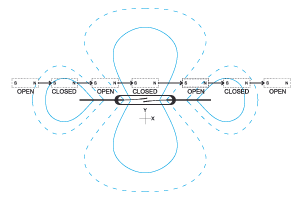 Many liquid level switches work with magnetic fields that are used to open and close switch points. It’s a clever, yet simple, type of sensor that has been a staple in level measurement for a long time now.
Many liquid level switches work with magnetic fields that are used to open and close switch points. It’s a clever, yet simple, type of sensor that has been a staple in level measurement for a long time now.
But how does it really work? How are magnetic fields harnessed as the working principle in many liquid level switches? We’ll explore how magnetic fields behave and how this behavior is controlled to operate a switch point.
A magnetic liquid level switch consists of two main components: a magnet embedded inside a float, and a reed switch placed in an enclosure – often a plastic, brass or stainless steel stem.
 It may not be too hard to imagine a magnet placed inside a float. However, it’s a little harder to understand a reed switch. A reed switch consists of two ferromagnetic contact tips (reeds) encased in a glass tube. When a magnet passes over the reed switch, the reeds close together, completing the signal circuit.
It may not be too hard to imagine a magnet placed inside a float. However, it’s a little harder to understand a reed switch. A reed switch consists of two ferromagnetic contact tips (reeds) encased in a glass tube. When a magnet passes over the reed switch, the reeds close together, completing the signal circuit.
The on/off nature of the signal current is used to identify when a liquid has reached a certain level. You can use it to start and stop things like alarms, pumps, and to open and close valves. This is why liquid level switches are still so popular.
 The magnetic field used to close the reed switches has certain characteristics that determine exactly where we can put magnetic floats and reed switches in relation to each other. The magnet creates a field around the reed switch as it approaches with center and outer lobes. Once understood, you may be able to modify your liquid level switch slightly within the boundaries of that magnetic field, depending on the type of sensor (more on that later).
The magnetic field used to close the reed switches has certain characteristics that determine exactly where we can put magnetic floats and reed switches in relation to each other. The magnet creates a field around the reed switch as it approaches with center and outer lobes. Once understood, you may be able to modify your liquid level switch slightly within the boundaries of that magnetic field, depending on the type of sensor (more on that later).
The center lobe of the magnetic field is the strongest, and is therefore the one we use to close the reeds. We control this by restricting the movement of the float and magnet. On a stem float switch, we use float stops to ensure repeatable performance. For side-mounted liquid level switches, the magnet is simply guided directly to the reed switch.
The magnetic field also determines whether or not the reeds are opened or closed as the magnet approaches. To specify how things need to be set-up, you must order the liquid level switch either normally open or normally closed.
This describes what the reed switch is doing when the float (and magnet) is at rest – or in its “normal” state.
Now that we understand how the magnetic field that forms around the reed switch affects the operation of the liquid level switch, you can perform two of what I would call science experiments. You can adjust the float switch to behave differently than specified.
This, of course, is not recommended. But if you need to make a rare change in the field, these tips just may help you out.
DISCLAIMER: Before we get into the details, always contact your manufacturer before you start messing around with changing your sensors. You’ll need an FL or FLE float from APG in order to get the results as described in this article. All liquid level switches are designed a little differently.
Experiment 1: Changing the Normally Closed/Open State On A Stem Float Switch
Perhaps the easiest change you can make in the field is reversing the normal state of the liquid level switch. You can do this by sliding your magnet, which means moving your float up or down.
You need to be careful about the exact placement of the float, but you can slide your float stops up or down and get a complete role reversal. If your switch was normally open, moving it up will make it normally closed (and vice versa).
If you’re going to attempt this one, we recommend using a voltmeter to verify your switch position as you move your float. Get a marker to keep track of where your float stops need to move.
On miniature liquid level switches, the float moves very little. On these, you may be able to achieve the same affect by taking the float off and turning it around. Many are designed to make this easy – giving you control over the normal switch state.
Experiment 2: Changing the Switch Point Level On A Stem Float Switch
You can also move the float up or down to effectively change the switch point on the liquid level switch. The outer lobes of the magnetic field on the reed switch will close the reeds when a magnet passes through them. These lobes actually continue to extend down the stem of the sensor, weakening as they go along.
This will vary based on the reed switch itself, as they have different sensitivity ratings. However, the furthest we’ve been able to move a float is to the second outer lobe. As a point of reference, this shouldn't be any further than about 1/2 an inch.
Now that you know all about magnetic fields and liquid level switches, make sure you stay in contact with your manufacturer to avoid damaging your sensor or voiding any warranties. This is a fun topic, but it comes with uncertainty as all float switch models vary in design and operation.
That said, contact us, or drop our Measurement Experts an email, with any question you may have about liquid level switches. We’re happy to give you the thorough answers you’re looking for.